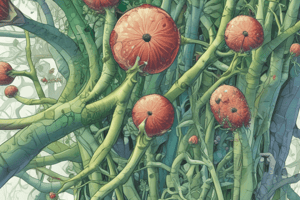Podcast
Questions and Answers
What is an example of negative tropism?
What is an example of negative tropism?
- Coiling of twiners and tendrils when they come in contact with an object of support
- The leaflets of Mimosa pudica drooping down when they are touched
- Growth of roots within the soil (correct)
- Ivy growing on the walls after contacting the wall
What type of movement is seen in the leaflets of Mimosa pudica when they are touched?
What type of movement is seen in the leaflets of Mimosa pudica when they are touched?
- Heliotropism
- Nastic movement (correct)
- Hydrotropism
- Thigmotropism
What is the direction of growth in positive hydrotropism?
What is the direction of growth in positive hydrotropism?
- Away from water
- Toward water (correct)
- Perpendicular to water
- Angular to water
What type of tropism involves a response to temperature changes?
What type of tropism involves a response to temperature changes?
What is the main difference between thermotropism and thermotaxis?
What is the main difference between thermotropism and thermotaxis?
What type of cells have been reported to show electrotropism?
What type of cells have been reported to show electrotropism?
What is the term for growth responses that are directed toward the stimulus source?
What is the term for growth responses that are directed toward the stimulus source?
What is the term for growth responses that are perpendicular to the direction of the stimulus?
What is the term for growth responses that are perpendicular to the direction of the stimulus?
What is the main difference between heliotropism and phototropism?
What is the main difference between heliotropism and phototropism?
Which type of tropism has the most influence on root growth?
Which type of tropism has the most influence on root growth?
Study Notes
The Meaning of Tropism
- Tropism originates from the Greek word "tropos," meaning a turning.
- It refers to the ability of an organism to respond to a stimulus by turning or moving in a specific direction.
Tropism in Pathogens
- Tropism is the ability of a pathogen to infect a specific location or organ.
- Organ or tissue tropism shows the ability of a pathogen to invade a specific organ or group of organs.
- Some pathogens are broadly tropic, infecting many organs, while others are restricted to a specific tissue.
Types of Tropism
- Positive tropism: the movement or growth response of an organism is toward the stimulus.
- Negative tropism: the movement or growth response of an organism is away from the stimulus.
Tropism in Plants
- Tropism is the growth movement of a plant in response to an external stimulus.
- It is different from taxis, where the organism shows a behavioral response to an external stimulus resulting in movement.
- Tropism is different from kinesis, where the movement is random in response to a stimulus.
Auxin and Directional Growth
- Auxin plays a major role in growth-mediated plant movements.
- Auxin can promote or inhibit cell elongation.
- Auxin is produced at the apical region of the shoot and is carried to other plant parts through auxin carrier proteins.
Types of Tropism in Plants
- Phototropism: growth or movement of a cell or organism toward light.
- Geotropism (gravitropism): growth or movement of a cell or organism in response to gravity.
- Chemotropism: growth or movement of a cell or organism in response to chemicals.
- Hydrotropism: growth or movement of a cell or organism in response to water or moisture.
- Thigmotropism: growth or movement of a cell or organism in response to touch.
Other Plant Tropisms
- Heliotropism: growth or movement of a cell or organism in response to sunlight.
- Thermotropism: growth or movement of a cell or organism in response to temperature changes.
- Electrotropism: growth or movement of a cell or organism in response to an electric field.
Studying That Suits You
Use AI to generate personalized quizzes and flashcards to suit your learning preferences.
Description
This quiz explores the concept of tropism, its origin, and its importance in the context of living organisms, including plants and pathogens.




